Seven Wildlife-Friendly, Heat-Tolerant Perennials
Views: 6463
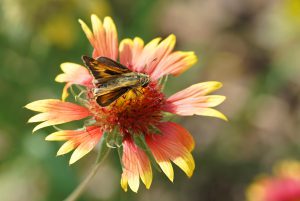
This blog follows my entry about heat-tolerant annuals. As I’ve written before, natives tend to be more wildlife friendly than non-natives since they often serve as host plants for lepidoptera (butterflies and moths) as well as food for insects that get eaten by birds and other animals. We are lucky in that many heat-tolerant perennials are native to our prairies and deserts, and they will do just fine in your gardens, too, given the right conditions. Because of their origins, most of these natives will prefer full to partial sun.
These plants have various soil preferences, but all will do well in summer heat, and most on this list are drought-tolerant, too. You may not be familiar with all these plants because some are not widely cultivated. However, nurseries that specialize in natives may carry them, and many can also be propagated from seed that is sold through various native seed companies including Native American Seed.
Here are seven wildlife-friendly, heat-tolerant perennials:
Drummond’s aster (Symphyotrychum drummondii)
I almost feel like I’m cheating putting this native on the list because the asters in my yard don’t start blooming until the end of summer and into fall. However, bloom times vary, and these plants survive the summer heat with very little care. Drummond’s asters will do well even in shade, one of the few plants on this list that will. They attract a variety of pollinators; mine are a favorite of “Blue” butterflies.
Hummingbird shrub (Anisacanthus quadrifidus)
A Texas native, this small shrub produces red, tubular flowers right when summer starts heating up. Hummingbirds and Sulphur butterflies love these flowers. I had Anisacanthus quadrifidus wrightii (36″h x 36″w) in a container for two years, and it did just fine. It filled out better in the ground, both in sandy soil and clay, so it seems to tolerate a wide variety of soils.
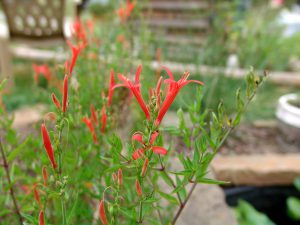
Hummingbird shrub, Anisacanthus quadrifidus wrightii
Coreopsis
Native to the Americas, coreopsis species can be found growing wild along roadsides and fields. Also known as tickseed, many species have been cultivated, but all serve as pollen and nectar sources for insects, moths, and butterflies. Birds will eat the seeds. Coreopsis is also host plant to a moth, Coleophora acamtopappi. Coreopsis must have well-drained soil, but in my experience some cultivars need to be watered more frequently than other xeric/water-wise plants in my beds, so watch them closely for stress. Deadheading will extend bloom time. Coreopsis varieties are consistently some of the best performers in my butterfly gardens.
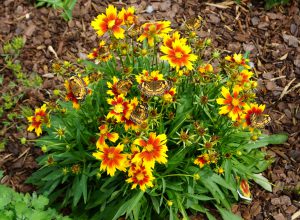
Coreopsis covered in Silvery Checkerspot butterflies.
Gaillardia
Gaillardia, a genus in the sunflower family, are native to North and South America. My experience with most gaillardia is that they are very short-lived perennials (two years), but they often self-seed. I have extensive experience with two: Gaillardia pulchella, which I think of as the classic “Indian Blanket flower,” and MesaTM Yellow, a cultivar that never seems to stop blooming. Both are extremely heat-tolerant and attract pollinators. Gaillardia are host plants to a few species of moth.
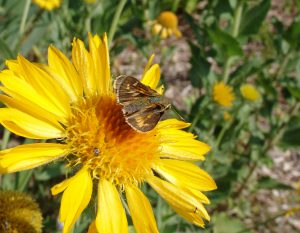
MesaTM Yellow gaillardia with a Sachem Skipper.
Lead plant
Amorpha canescens, also called Prairie shoestring, is a small shrub native to the central plains of North America, in areas with dry, well-drained soil. The roots of this plant go deep and spread wide, so you need to plant it in the ground. It isn’t too picky about soil type as long as it drains well. Lead plant’s root system makes it extremely drought and heat tolerant. Its flowers are of special value to native bees, but butterflies and other pollinators will flock to them, as well. Rodents and deer eat the seeds. Various animals will browse it.
Maximillian sunflowers
Native to most of North America and Canada, this sunflower is attractive to bees and butterflies, and the seeds are eaten by many different birds. Maximillian sunflowers spread by rhizomes, and they are tall. They are best naturalized in areas they can form colonies or used at the back of the border. I planted mine along a fence line, and they spread only slowly. A friend planted them on a berm and has to pull them out by the handful every spring. We are both fond of them for their glorious color in late summer.
Slender mountain mint
Pycnanthemum tenuifolium is a member of the mint family. As far as I can tell, this plant will do well anywhere, in any soil, as long as it isn’t full shade. One website I checked said it prefers acidic soil, but it was very healthy in the slightly alkaline soil of my Oklahoma butterfly garden. Native bees and honeybees love it. So do butterflies. Birds eat the seeds, and deer eat the leaves. I wouldn’t be too concerned about the deer; this plant is so hardy it will likely come back from any browsing.
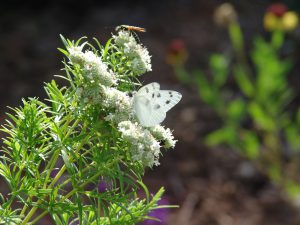
Checkered White butterfly on Pycnanthemum tenuifolium.
Coreopsis, gaillardia, and hummingbird shrub will do well in containers. The others on this list will do better planted in flowerbeds or landscapes. These seven wildlife-friendly, heat-tolerant perennials will draw wildlife in the heat of summer and early fall.
Meet Leslie Miller
Leslie Ann Miller shares 3.5 acres in rural Oklahoma with birds, butterflies and wide variety of animals. She is currently transforming her yard with plantings…
Leslie's Recent Posts
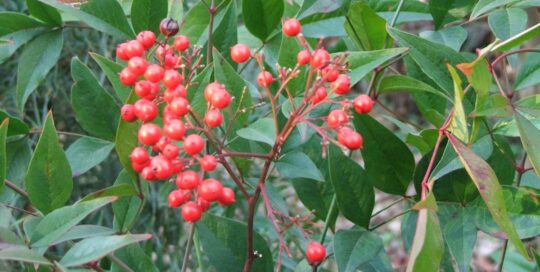
Nandina Berries Are Potentially Harmful to Birds: A Warning






